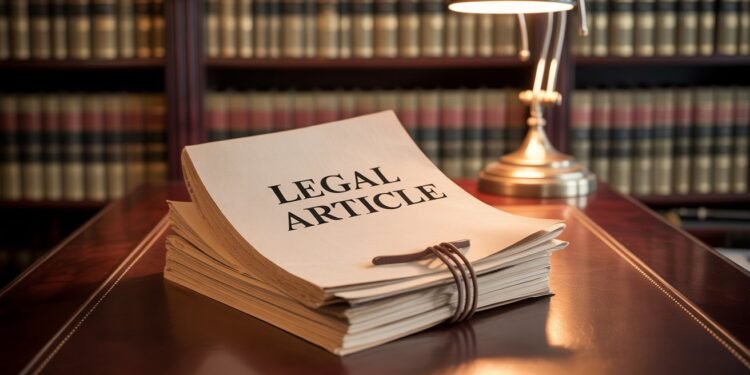Author: Adv. Yogesh, pursuing my LL.M at Dayananda Sagar University, Bengaluru.
Introduction
The law has always evolved as technology has changed. For instance, it has changed from typewriters to e-filing, from virtual hearings to AI-powered legal research. But what if machines were the ones that were attacking each other? A world where AI systems can not only sign contracts but also solve their own problems without needing attorneys or courts. The concept of AI-to-AI arbitration enunciates that autonomous vehicles will eventually utilize algorithm programs to resolve legal disputes among themselves.
- What does it mean for AI systems to arbitrate?
When two AI systems or autonomous agents settle a conflict, this is called AI-to-AI arbitration. This usually happens through automated arbitration procedures that can look at data, interpret rules, and make conclusions on their own.
- The Foundation of Technology
The three fundamental pieces of AI-to-AI arbitration are smart contracts, blockchain, and machine learning. Smart contracts are agreements that are kept on the block chain and can be carried out without any help. AI employs machine learning to figure out the best and fairest approach to use contract logic.
- What is the need for arbitration in machines?
AI systems can handle transactions, supply chains, and digital exchanges on their own, but things go wrong when the coded instructions don’t match. AI arbitration allows systems get to a swift, logical conclusion without any human delay. This process ensures that autonomous systems are fair, transparent, and do what they’re supposed to do.
- How AI to AI Arbitration Works
AI systems automatically look for conflicts and send them to a pre-set arbitration mechanism. This module looks at data that has been verified by blockchain, applies legal or contractual rules, and gives out a digital prize that can be enforced according to the rules set down.
- Importance of the Indian Arbitration and Conciliation Act, 1996
Section 7 of the Indian Arbitration and Conciliation Act of 1996 enumerates that arbitration is a process or a mechanism for disputed parties to amicably settle their issues or disputes by consenting to let an arbitrator decide instead of going to court. For AI-to-AI arbitration to be accepted in India, it must meet three basic legal requirements:
- There must be an arbitration agreement under Section 7(1) that the individuals or enterprises that the AIs stand for agree to.
- Section 31(3) says that the award must be fair and follow the rules.
- This would be enforced by Section 36, but Section 34 would preserve public policy.
If AI agents do what their principals (the people or businesses that own them) tell them to do, the arbitration clause in a smart contract could be seen as a valid arbitration agreement. The Indian Evidence Act may also enable evidence from the blockchain, which would make it easier to enforce these kinds of awards.
- Main Benefits
AI-to-AI arbitration is quick, inexpensive, reliable, and can grow. Digital economies perform better when autonomous agents can decide thousands of tiny arguments on their own, without any aid from people.
- Problems with the law and ethics
Being responsible, fair, honest, and a lawful person are the hardest things to do. AI systems are not considered as legal bodies or entities; hence they cannot enter into legally binding contracts or be held accountable for their misconduct. One of the most pertinent things to work on in the future is making sure that AI decisions are fair, transparent and clear to understand.
- Changes around the world
AI tools are now being employed in court proceedings in Hangzhou, Beijing, and Guangzhou, China. AI has also been tried out in managing small claims and arbitration in Singapore and Estonia. These advances are steps toward automated justice, even though they don’t have full AI-to-AI systems yet.
- What Will AI-to-AI Arbitration Look Like in the Future?
AI-to-AI arbitration may be pivotal in conflicts regarding finance, autonomous vehicles, the Internet of Things, and the metaverse. If technology is properly regulated and scrutinized, it could lead to expedient, fairer, and more open solutions while yet sustaining human ethical oversight.
Legal Structures for AI and Algorithms in Europe and India
The rapid expansion of AI and algorithmic technologies has prompted legal systems worldwide to rethink their understanding of responsibility, fairness, and regulation. The European Union has become a pioneer in setting broad legal standards for the ethical and legal use of AI. The European Union Artificial Intelligence Act (EU AI Act, 2024) is a major big effort in the world to set up a set of rules that all AI systems must follow. It uses a risk-based classification model to group AI applications into groups like “unacceptable risk,” “high risk,” “limited risk,” and “minimal risk.” Systems that are regarded as high-risk, like those used in law enforcement agencies, hiring, or delivering justice, must meet strict standards for transparency, human oversight, and data quality.
The EU’s stand is not just technical; it is also very moral, focusing on human dignity, accountability, and not treating people differently. To avoid bias, lack of transparency, or harm, algorithms must be able to be audited and follow systemized ethical rules. The EU has also included AI principles in its General Data Protection Regulation (GDPR). For example, the “right to explanation” gives people the right to seek for more details about algorithmic decisions that have an effect on them. This is very important for automated dispute resolution systems and AI-to-AI arbitration, where decisions need to be shift, comprehensive, and legally sound. The European model aims to guarantee that, even when machines engage or arbitrate independently, their process remains grounded in human-centric legal principles.
The European Commission’s High-Level Expert Group on Artificial Intelligence has also released some ethical guidelines that support the EU’s position. These guidelines list pertinent values like fairness, accountability, transparency, and robustness. These principles call for a balance between new ideas and rules, making sure that algorithmic systems make the world a ideal place instead of making it worse. In the context of AI-to-AI arbitration, this means that algorithmic decisions must be able to be explained, cross checked, and in line with the public policy standards that make any arbitral process legal.
India’s rules for AI and algorithms, on the other hand, are still being worked out, but they have come a long way in the last few years. The Information Technology Act of 2000 is still the main law that regulate digital and automated systems. It deals with things like electronic contracts, authentication, and liability. But with the rise of autonomous technologies, India has started to make new rules that focus on responsible innovation. The Digital Personal Data Protection Act, 2023, is a big move forward because it makes data fiduciaries responsible and gives people rights over how their personal data is processed and stored. This is an important part of keeping AI systems safe.
NITI Aayog, India’s policy think tank, also came up with the “Responsible AI for All” strategy, which focuses on the two goals of ethics and inclusion. This organized framework calls for the use of AI systems that are open, safe, and welcoming, and it suggests setting up regulatory sandboxes to test the fairness of algorithms before they are widely used. These principles are very important for arbitration. As India moves toward accepting smart contracts and machine-assisted dispute resolution, it will be very important to make sure that algorithms are accountable and that data is reliable in order to keep the public’s trust and the law’s enforceability.
When we have a glance at things from a comparative view, we can see that the EU has already made its principles into law, while India’s approach is still based on policies and its interpretation, with a lot of help from new ideas from the courts and guidance from the government. Nevertheless, Indian judicial system has shown a willingness to accept digital and algorithmic advancements, as seen in the case of Trimex International FZE Ltd. v. Vedanta Aluminium Ltd. (2010), which upheld electronic contracts. As AI-driven arbitration becomes more famous, it would be helpful to have clear AI governance standards, like those in the EU, to make sure that automated awards are both legally sound and morally sound.
In the end, both the jurisdictions show that people are starting to realize that algorithms, even though they aren’t human, still have to follow the rules of fairness, accountability, and transparency in the legal systems that people have made. India could strengthen international trust in its digital economy by aligning its developing AI framework with the EU’s more practical regulatory model. This could also lead to globally interoperable stature for AI-to-AI arbitration, where fairness and legality are built into the machines’ code.
Relevant Court Cases
India’s Bharat Aluminium Co. v. Kaiser Aluminium Technical Services Inc. (BALCO), (2012) 9 SCC 552
The Supreme Court made it evident that arbitration is based on the freedom of the parties involved and that courts should not get too involved in arbitration. This principle backs AI-to-AI arbitration because it also uses consent-based dispute resolution, which means that people agree to let autonomous systems act on their behalf.
Trimex International FZE Ltd. v. Vedanta Aluminium Ltd., (2010) 3 SCC 1 – India
The Court said that even digital agreements and electronic communications can make contracts that are legally binding if both parties agree to them. This decision makes smart contracts used in AI-to-AI arbitration more valid, since the agreements may only exist in digital form.
Westacre Investments Inc. v. Jugoimport-SDRP Holding Co. Ltd. [1999] QB 740 (UK Court of Appeal) – International
The Court said again that arbitral awards should usually be enforced unless they go against basic public policy. This is in line with Sections 34 and 36 of the Indian Arbitration Act, which means that even AI-generated arbitral awards could be upheld as long as they are fair and legal.
Conclusion
AI-to-AI arbitration is the next big thing for settling fights. In this situation, people write the rules that machines use to settle their own arguments. There are still issues with being fair and holding people accountable, but placing it into the Indian Arbitration Act is a positive first step toward achieving legal acceptance. The idea is not to get rid of people who make decisions, but to make the digital world fair. When robots are in a dispute, the arbiter must be smart and fair.



